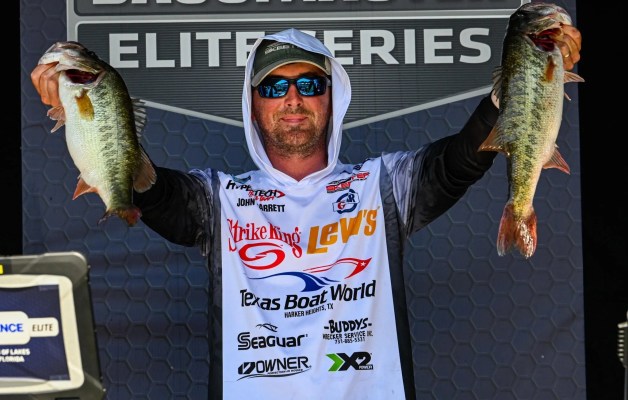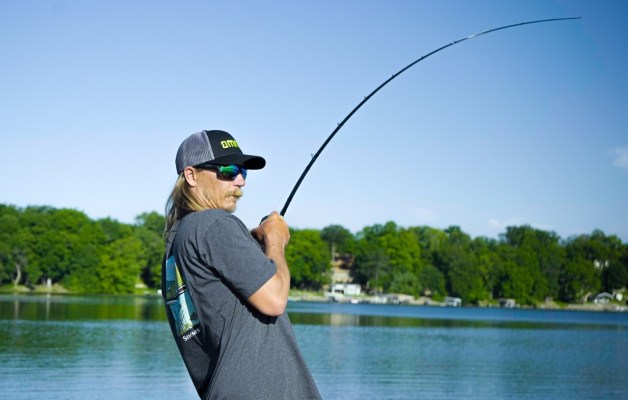The best thing about bass fishing in January, especially in the Deep South, is that you know exactly where they'll be holding — under vegetation mats. Heat is the most likely explanation for that. As the sun shines down on the water's surface everything warms up. Vegetation mats accelerate that process. The water under them is the warmest of all.
To flip and pitch your way through mats — and pull giant bass out from under them — you need heavy tackle. I start with my American Rodsmiths Big Nasty rod. It's 7 feet, 7 inches of raw power. Naturally, I mount my Ardent F700 Flip & Pitch reel on it, spooled with 60-pound-test braided line.
My bait is a Strike King Perfect Plastic Rodent or a Rage Tail Space Monkey.
I use a Tru-Tungsten Denny Brauer Flippin' Weight between 1 and 1 1/2 ounces. This sinker is designed weight-forward with a different balance point. It has a neck which allows it to break over and fall through with the bait following it down, rather than have everything lying on top of the mat and being useless.
My hook is big and strong. I like 5/0 or 6/0 Mustad Flipping Hooks. Nothing less will do the job for me.
I always — no exceptions — peg my sinker. One of the easiest and simplest ways to do this is to use the Peter T Smart Peg system. It's first-class all the way. Everything you'll need for that system can be purchased from Tru-Tungsten.
That said, I come from the old school. My preference is to use a rubber nail.
I insert the nail through the sinker and peg the line in place. Once I have the line secure, I cut the back end off the nail. I then pull the nail into the weight until it's pegging the front half of the sinker. This allows the line to re-center itself at the bottom of the sinker. After that I trim the nail at the top and I'm good to go. Everything is perfectly centered between the weight, the line and my bait.
Note: There are a lot of good anglers who'll tell you that it's better not to peg the sinker. They believe there should be separation between the weight and the bait as they fall. I respect their opinions, as well as their skills, but I stand by my advice. Always peg your sinker. It'll help pull your bait through the mat, and give you a better feel.
Once you're all geared-up it's time to attack the mat. I use enough weight to get me through the canopy and then let the bait free fall to the bottom. I work my bait slow, maintaining contact with the bottom… at first.
If that doesn't generate a bite, I'll work my plastic up through the water until it's directly below the vegetation. At that point I bang my bait onto the underside of the mat.
Sometimes the fish will be right on the bottom under these mats. Just as frequently, however, they'll be right under the vegetation. (They may position themselves there because the water's warmer.) If you only bounce your plastic off the bottom, you'll miss the higher bite.
Now, a word or two is in order about how to get big fish out from under heavy mats. This is a skill that often means the difference between a fantastic day on the water and one of frustration.
First, set the hook properly. That means hard. This is not finesse fishing. You're using heavy tackle. Take advantage of it.
The next thing to keep in mind is that a bass will stop fighting once her eyes — most of your big bass at this time of the year will be females — are covered over. If you get her to the top of the mat, but she won't break through, don't horse her or continue to try to pull her through the mat. If you do, you'll pull the hook loose.
Just hold her in position and go over to get her with your hands. Don't hurry. You have two days to get there if you need that much time. She isn't going anywhere as long as she is blind.
One final thought: The kind of fishing I've just described is not for numbers anglers. January fishing under mats in the Deep South is for guys who want to get five bites a day that might total 35 pounds. If you want to catch 20 or 30 fish, do something else.
In our next lesson we'll talk about where bass like to hold under mats. With that knowledge, you'll be able to make your first cast your best cast.





